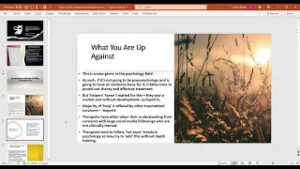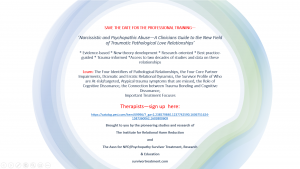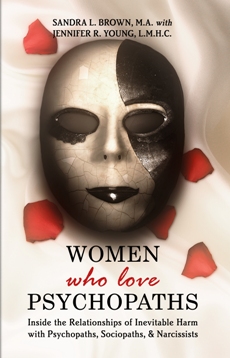by Sandra L. Brown, MA
A large portion of emotional and physical abusers (although not all) have some similar identifying disorders, traits, or diagnosis. They are not all created equal. That means each one of them brings a unique combination of traits, challenges, and problems to the equation of the relationship and even therapy. Therefore, not all abusers treatment is going to be effective because not all psychological problems are treatable. For instance, batterer intervention has often failed to make this distinction and lumps all violent behavior or psychological problems together as if they are not differentiated by their differences.
Some of the disorders have biological and neurological root causes that are not curable. Ultimately, not all problem relationships have a solution especially those that have biological/neuro problems at their basis. That’s not popular to hear. We live in an Oprah-age of psychology that believes all disorders are curable and if not curable, at least highly treatable. ‘Law of Attraction’ type thinking pulls many people into believing ‘if they think it, they can make it happen’ (their relationship will work, the pathology will be gone, or something curative will happen that will drive away the symptoms.) Like medicine, psychology faces the same challenges that not all disorders have a satisfactory treatment or a cure.
If people who are in problem relationships want to avoid future problem relationships, they must understand what contributes to some of the disorders and the signs within the behavior. There is no doubt that chronic personality problems wreak havoc in relationships and the worst of these do have commonalities related to impulsivity, emotional dysregulation, and violence. (No abuse is mild. I’m not suggesting that. What I am trying to hone in on is the chronic and lethal nature of some of the relationships and what some of the contributing factors can be to those problems.)
Some of the more recent research in neuroscience helps us to understand the problems related to what Otto Kernberg (one of the renowned writers and researchers of pathology) wrote about as ‘severe personality disorders’ related to Cluster B disorders (see his books Aggression in Personality Disorders and Perversions; Severe Personality Disorders; Aggressiveness, Narcissism and Self Destructiveness in the Psychotherapeutic Relationships–to name a few).
However, neuroscience over the past few years has helped us understand the additional possible biological and neurological roots of some of these severe disorders as well as the disorders of sociopathy and psychopathy. MRIs of various Cluster B disorders and sociopathy/psychopathy have lead the way noting similarities in brain formations, brain activity, brain circuitry, brain chemistry and its relationship to the severe disorders, impulsivity, poor treatment outcomes, and poor relationship outcomes. Where therapy has spent decades (if not a century) focused on the very psychoanalytic and behavioral approaches, we have missed the very real potential of neurology and brain functioning challenges.
While the origin and etiology of these disorders has been widely debated for decades, neuroscience is providing many of the answers to biology that we previously didn’t have. This helps us delineate between the mind as a structure and process, and the brain as an organ. The brain as an organ has all the proclivity of being born with differences, challenges, and problems as any other organ in the body. Unfortunately, up until now, the view has been a very ‘psychological’ approach to the brain and its disorders without looking at the possible contributions of ‘nature’ such as being born with physical predispositions. While we don’t question that, when it comes to the heart or immune system, people can be born with abnormalities, people certainly have a BIG reaction at the thought of psychology being related to brain organ issues and not merely emotional issues.
When looking at the behaviors associated with problem partners with what is referred to as ‘severe personality disorders’ and the problems of sociopathy and psychopathy, we have to look broadly at the symptoms, but not so broadly that we find loopholes. Normally, one symptom off a behavioral list does not constitute one of the ‘severe personality disorders’ or even the no/low-conscience disorders of sociopathy or psychopathy. However, they don’t need to have ALL of these traits in order to be problematic in a relationship.
Those in relationships with problem partners often fall on the side of ‘too much empathy’ and give the problem partner more credit for not having these symptoms than what is warranted. Somewhere in the middle of one trait-too-many/and no-they-don’t-have-problems-at-all, is a snap shot of relationship problems and problem partners. Here are some of the behaviors associated with what is referred to as some of the severe personality disorders as well as sociopathy and psychopathy.
From the Diagnostic Statistical Manual–DSM V:
- Disregard for, and the violation of, the rights of others
- Failure to conform to lawful social norms
- Deceitfulness Impulsivity or failure to plan ahead
- Irritability and aggressiveness as indicated by repeated physical fights or assaults
- Reckless disregard for the safety of self or others
- Consistent irresponsibility as indicated by repeated failure to sustain consistent work behavior or honor financial obligations
(Above are related to Antisocial Personality Disorder)
- Lack of remorse as indicated by being indifferent about having hurt, mistreated or stolen from another
- Glib and superficial charm
- Grandiose (exaggeratedly high) estimation of self
- Need for stimulation
- Pathological lying
- Cunning and manipulativeness
- Lack of remorse or guilt
- Shallow affect (superficial emotional responsiveness)
- Callousness and lack of empathy
- Parasitic lifestyle
- Poor behavioral controls
- Sexual promiscuity
- Early behavior problems
- Lack of realistic long-term goals
- Impulsivity irresponsibility
- Failure to accept responsibility for own actions
- Many short-term relationships
- Juvenile delinquency
- Revocation of conditional release
- Criminal versatility
(Above are related to Sociopaths/Psychopaths)
- Frantic efforts to avoid real or imagined abandonment
- Intense and unstable personal relationships that over idealize and devalue
- Identity disturbance with unstable self image or sense of self impulsivity in at least two areas (spending, sex, substance abuse, reckless driving, binge eating)
- Recurrent suicidal behavior, gestures, threats or self-mutilation
- Emotional instability due to a marked reactivity of mood (intense episodic irritability or anxiety)
- Chronic feelings of emptiness
- Inappropriate intense anger or difficulty controlling anger
(Above are related to Borderline Personality Disorder)
- A grandiose sense of self importance
- Exaggerates their achievements and talents
- Expects to be recognized as superior without commensurate achievements
- Is preoccupied with fantasies of unlimited success, power, brilliance, beauty, or ideal love
- Believes that he is special and unique and can only be understood by, or should only associate with, other special or other high-status people or institutions.
- Requires excessive admiration
- Has a sense of entitlement, unreasonable expectations of especially favorable treatment or automatic compliance with his expectations.
- Is interpersonally exploitative within relationships and takes advantage of others to achieve his own ends
- Lacks empathy and is unwilling to recognize or identify with the feelings and needs of others
- Is often envious of others or believes that others are envious of him
- Shows an arrogant, haughty behavior or attitude
(Above are related to Narcissistic Personality Disorder)
This list is not mild relational infractions, or merely what Dr. Phil refers to as ‘deal breakers’. In some of the more chronic features and behaviors, this pathology causes debilitating partner aftermath symptoms.
The Institute is involved in offering recovery to those coming out of relationships with narcissists, antisocial, sociopathy and psychopaths because the chronicity of their disorders often causes chronicity within their relationships. If that weren’t true, 60 million people would not be negatively affected by someone else’s pathology. We wouldn’t have support groups for “Partners of Narcissists” or “Adult Children of Narcissistic Personality Disorder”. There wouldn’t be self help books for those harmed by anti-socials or psychopaths. The Institute wouldn’t have felt it necessary to write ‘Women Who Love Psychopaths’ and offer coaching and retreats for survivors.
Some of those listed above are the abusers who are not created equal, who have permanent neuro, emotional, behavioral and psychological disorders that bypass what psychology can do for them. Anger management–nope. Batterer intervention–nope. Intensive psychotherapy–nope.
The permanent forms of pathology are noted for their Three Inabilities (Brown, 2005):
* Inability to grow to any authentic emotional or spiritual depth
* Inability to sustain positive change
* Inability to develop insight how their behavior negatively affects others
These inabilities are the hallmark of chronic disorders that create chronic problem relationships.
** Footnote: Research articles related to this topic: ‘Neural foundation of moral reasoning and antisocial behavior;’ ‘Into the Mind of a Killer: Brain imaging studies starting to venture into the research of criminal psychopathy;’ ‘Tridimensional Personality Questionnaire data on alcoholic violent offenders: specific connections to severe impulsive cluster B personality disorders and violent criminality” ‘The Relationship Between DSM-IV cluster B personality disorders and psychopathy according to Hare’s criteria: Clarification and resolution of previous Contractions;’ ‘Brain imaging abnormalities in borderline personality disorder’ (video)’ ‘Potentials implicate temporal lobe abnormalities in criminal psychopaths;’ Hypomanic symptoms predict an increase in narcissism and histrionic personality disorders;’ and ‘The Brain and Personality Disorders.’
(**If we can support you in your recovery process, please let us know. The Institute is the largest provider of recovery-based services for survivors of pathological love relationships. Information about Pathological Love Relationships is in our award-winning book, Women Who Love Psychopaths, and is also available in our retreats, 1:1s, or phone sessions. See the website for more information.)






